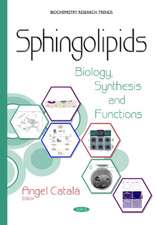Microcomputers and Laboratory Instrumentation
Autor David J. Malcolme-Lawesen Limba Engleză Paperback – 29 iul 2012
| Toate formatele și edițiile | Preț | Express |
|---|---|---|
| Paperback (2) | 389.88 lei 6-8 săpt. | |
| Springer Us – 29 iul 2012 | 389.88 lei 6-8 săpt. | |
| Springer Us – 26 sep 2011 | 390.08 lei 6-8 săpt. |
Preț: 389.88 lei
Nou
Puncte Express: 585
Preț estimativ în valută:
74.61€ • 77.61$ • 61.60£
74.61€ • 77.61$ • 61.60£
Carte tipărită la comandă
Livrare economică 14-28 aprilie
Preluare comenzi: 021 569.72.76
Specificații
ISBN-13: 9781461574330
ISBN-10: 1461574331
Pagini: 260
Ilustrații: X, 246 p.
Dimensiuni: 178 x 254 x 14 mm
Greutate: 0.46 kg
Ediția:Softcover reprint of the original 1st ed. 1984
Editura: Springer Us
Colecția Springer
Locul publicării:New York, NY, United States
ISBN-10: 1461574331
Pagini: 260
Ilustrații: X, 246 p.
Dimensiuni: 178 x 254 x 14 mm
Greutate: 0.46 kg
Ediția:Softcover reprint of the original 1st ed. 1984
Editura: Springer Us
Colecția Springer
Locul publicării:New York, NY, United States
Public țintă
ResearchCuprins
1 Introduction.- 1.1 Laboratory instrumentation and microcomputers.- 1.2 Measurement systems.- 1.3 Electronic black boxes.- 1.4 A practical footnote.- 2 The Basics of Laboratory Signals.- 2.1 Transducers.- 2.2 Measurement signals.- 2.3 The transducer connection.- 2.4 Noise and interference.- 2.5 Minimising interference.- 2.6 Signal-to-noise ratio.- 2.7 Control signals.- 3 The Elements of Analog Signal Handling.- 3.1 Op-amps.- 3.2 Feedback systems.- 3.3 Basic amplifier configurations.- 3.4 Bandwidth and slew rate.- 3.5 Practical dc signal circuits.- 3.6 Ac signal circuits.- 3.7 Integrators.- 3.8 Differentiators.- 3.9 Pulse amplifiers.- 3.10 Filters.- 4 The Elements of Digital Signal Handling.- 4.1 Logic gates.- 4.2 TTL families.- 4.3 CMOS families.- 4.4 CMOS and TTL together.- 4.5 MSI circuits.- 4.6 Generating logic levels.- 4.7 Analog/digital interconversion.- 4.8 Serial digital signals.- 5 The Modern Microcomputer.- 5.1 The eight bit micro.- 5.2 The programming language.- 5.3 The operating system.- 5.4 Peripherals.- 5.5 Byte handling busses.- 5.6 The video display.- 5.7 Bit manipulation.- 5.8 Timing and addressing.- 5.9 Interrupts and interrupt flags.- 5.10 The 16 bit micro.- 6 Interfacing Microcomputers with Laboratory Instrumentation.- 6.1 Basic instrumental interface types.- 6.2 Multiplexing.- 6.3 Multiple byte interfaces.- 6.4 Interface control.- 6.5 Handshaking.- 6.6 Synchronous byte transfers.- 6.7 Dynamic interfaces.- 7 Standard Interface Systems.- 7.1 Introduction.- 7.2 The IEEE 488 standard.- 7.3 The RS232C link.- 8 System Design.- 8.1 An approach to system design / Case study.- Appendices.- Appendix 1 Decimal-hexadecimal conversion tables.- Appendix 2 The ASCII code.- Appendix 3 Sample assembler routine for GPIB adaptor.- Device index.
















